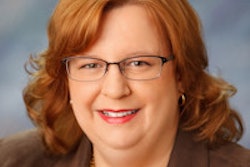
SAN FRANCISCO - If your institution doesn't have a lung cancer screening program, it's probably time to set one up, according to a presentation on Tuesday at the annual International Symposium on Multidetector-Row CT (MDCT).
If you work in a healthcare facility with a radiology department, you will have eligible patients asking for CT screening for lung cancer beginning in January, regardless of what decisions the U.S. Centers for Medicare and Medicaid Services (CMS) makes in the remaining months of this year, according to Dr. Jared Christensen, division chief of cardiothoracic imaging at Duke University Medical Center.
Since publication of the National Lung Screening Trial (NLST) results in 2011, which showed a 20% mortality gain from screening of long-term smokers, every major medical society that is a player in the field has endorsed low-dose screening for lung cancer, including the U.S. Preventive Services Task Force (USPSTF).
 Dr. Jared Christensen from Duke University.
Dr. Jared Christensen from Duke University.
CMS has yet to issue a national coverage decision that would make screening automatic for every high-risk individual with healthcare coverage; the agency will decide on that matter by November. But however that coin lands, Americans covered under the Affordable Care Act (aka Obamacare) will be eligible next year for lung cancer screening with no copay through any qualifying plan they have purchased through the exchange.
On the private insurance front, Blue Cross/Blue Shield covers qualified individuals in 31 states, with some counties excluded -- possibly those with higher lung cancer rates, according to Christensen. Another private insurer, Aetna, covers qualifying individuals in all 50 states if they have employer-based health insurance. And recently many congressmen have urged CMS to take action in favor of screening. However, many facilities simply consider it part of their healthcare mission.
"Many centers just want to remain competitive, and lung cancer screening is viewed as an important and valuable tool for improving health in the community, and [screening] is often desirable as part of a comprehensive lung cancer program," he said. " 'Should we set up a lung cancer screening program?' may have been a valid question three or four years ago, but I think with current data, the answer is a resounding 'yes.' "
Questions to answer
Before setting up a program, there are other questions to answer with important implications -- for example, which eligibility criteria to follow. With several societies having different criteria for screening eligibility, centers now have the freedom -- and the burden -- to choose which criteria to follow.
For example, NLST criteria require 30 pack-years of smoking history, but National Comprehensive Cancer Network (NCCN) criteria reduce it to 20 years if there is another predisposing factor for lung cancer. For its part, USPSTF raised the maximum age of eligibility to 80 years from NLST's 75-year cutoff. Which to choose -- a little of each? For now, it's up to each center to decide, Christensen said.
Do patients need to be referred by a screening clinic, or can they just present to radiology and get their screening scans? Do positive results go to a referring physician to initiate follow-up, is it the job of a special patient navigator, or is it the responsibility of the patient to enroll for follow-up when the positive results are received? Such questions need to be considered.
How much should the program charge? Right now, about 3% of the programs offer the service for free, about 9% of exams are covered by insurance providers, and the vast majority are self-pay, with exams initiated by patients. At Duke, 88% of screening subjects are self-pay, Christensen noted. The national average screening cost is about $230, with costs across the U.S. ranging from approximately $100 to $600. Some programs offer free screening but the patient pays for subsequent screens, with the insurer getting involved only in the event of a positive result.
If CMS, which faces an estimated five-year cost of $9.3 billion to implement screening and related services, declines to issue a national coverage determination (NCD) in November, the result could be a parallel system in which Obamacare insured and certain privately insured individuals have access to screening, but those with Medicare do not.
"Even if you don't have a current screening program in place, come January 2015 chances are you will have patients in your population who will be eligible for screening and who will request it," Christensen said.
Forming your team
You will need a range of clinical personnel in your circle of providers, including:
- Radiologists
- Pulmonary medicine specialist
- Tobacco treatment and counseling specialist
- Clinical and research coordinators
Other physicians, including family medicine, internal medicine, gastroenterologists, ob/gyn, and primary care, "are very important because they control the patients," Christensen said. "We want our primary care physicians to have lung cancer screening as part of their checklists, much like mammography or colonoscopy, when they see patients that meet the criteria."
Radiologists are responsible for controlling the quality of the exam, reporting the results, and balancing image quality with the low-dose technique, he said.
Patient schedulers and technologists also play important roles in the screening program. The radiology business manager, the hospital chief financial officer, and the patient revenue manager will need to have a hand in the process to control the program's effect on the facility's finances, Christensen said. Someone will also need to decide how aggressive the program should be in letting the community know about the service.
"As these factors come together, there are bound to be diverging interests, but it's important that you reach some common ground, particularly emphasizing the importance of having physician champions in your primary care physician groups," he said."Because if they're not thinking of screening, if they don't believe in its importance, they're not going to send patients for this valuable service."
The process at Duke was launched with grand rounds, community outreach efforts, webinars, and other steps to ensure that the new program would be visible in the community and to referring physicians, Christensen said.
At Duke, where Christensen is the radiology director, there is a clinical director, a thoracic surgeon who runs the screening clinic, and a clinical coordinator who serves as a patient navigator and follows up on findings. There is also a research coordinator, a business manager, and a marketing director, so the program is very much a team effort, he said.
"When it comes to the plan, our goal is to reduce morbidity and mortality through prevention and early detection and treatment, and we want patients in our area to think of Duke as the one and only stop to go for lung cancer services," Christensen said. Making sure patients aren't lost to follow-up is an important part of this mission.
Before the program officially began a couple of years ago, the team also took a look at local lung cancer statistics; they found that Wake County accounted for almost half of the predicted future cases. This knowledge helped the program coordinators ensure that this county and other areas with large projected lung cancer populations received adequate outreach, Christensen said.
They also modeled the number of patients at risk in the region based on NLST criteria. According to these numbers, even a 10% screening compliance rate would net about 5,100 screening exams per year and one lung cancer per week, the group calculated -- though they don't expect to see nearly that many patients arrive.
Toward implementation
When it comes to implementation, centers really need to do their prep work and make sure they have the infrastructure in place -- which means having the CT protocols, technologist training, reporting system, screening clinic, prevention plan, and institutional review board consents in place before the doors open, he said.
At Duke, patients call a number and are processed directly through the screening clinic, where their eligibility is confirmed based on NCCN guidelines. The order is then placed by the primary care physician or the physician running the screening clinic. From there, the order is scheduled, and the patient shows up on the day of screening; before the scan, he or she learns what to expect and pays the fee in advance. The patient's insurance is flagged to avoid a denial. After the scan, the radiologists have one hour to issue the results by calling the screening clinic.
"Often these patients are waiting" for their results, Christensen said. "While they're waiting, if they're current smokers they undergo treatment counseling." The program also sends letters to the referring physician, but it may begin sending them to patients if the practice is mandated in the future. The screening clinic oversees appropriate follow-up, and full program reviews occur every six months.
For negative versus positive screens, the clinic has begun implementing the American College of Radiology's (ACR) Lung-RADS system for reporting and management, which differs somewhat from the previous NCCN guidelines the center followed. Also, the USPSTF has issued guidelines for screening that differ slightly based on patient age, which the center is now following.
The Lung-RADS follow-up recommendations are based on nodule size and whether the nodule is new, while NCCN's recommendations do not differentiate between baseline and new nodules.
"There is some divergence and overlap between these," Christensen said. NCCN and ACR are meeting in the next few months to try to reconcile the different follow-up recommendations.
"What we decided to do is to follow the ACR's Lung-RADS for anyone who meets screening eligibility, regardless of whether it's a screening exam or an incidentally detected nodule, or a diagnostic scan," he said. "For everyone else, we actually follow the Fleischner [Society] criteria, which are different still. ... Pick a set of guidelines, and stick with it for consistency with your primary care physicians."



















